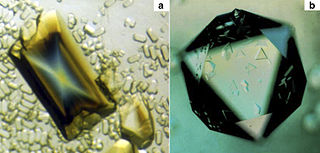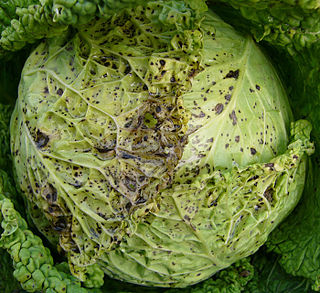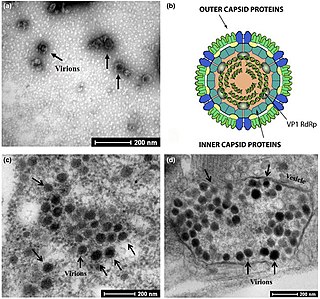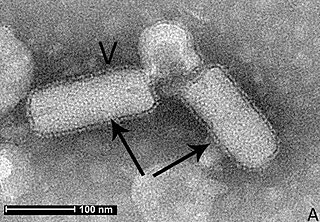
A satellite is a subviral agent that depends on the coinfection of a host cell with a helper virus for its replication. Satellites can be divided into two major classes: satellite viruses and satellite nucleic acids. Satellite viruses, which are most commonly associated with plants, are also found in mammals, arthropods, and bacteria. They encode structural proteins to enclose their genetic material, which are therefore distinct from the structural proteins of their helper viruses. Satellite nucleic acids, in contrast, do not encode their own structural proteins, but instead are encapsulated by proteins encoded by their helper viruses. The genomes of satellites range upward from 359 nucleotides in length for satellite tobacco ringspot virus RNA (STobRV).

Geminiviridae is a family of plant viruses that encode their genetic information on a circular genome of single-stranded (ss) DNA. There are 520 species in this family, assigned to 14 genera. Diseases associated with this family include: bright yellow mosaic, yellow mosaic, yellow mottle, leaf curling, stunting, streaks, reduced yields. They have single-stranded circular DNA genomes encoding genes that diverge in both directions from a virion strand origin of replication. According to the Baltimore classification they are considered class II viruses. It is the largest known family of single stranded DNA viruses.
Sequivirus is a genus of viruses in the order Picornavirales, in the family Secoviridae. Plants serve as natural hosts. There are three species in this genus. Diseases associated with this genus include: PYFV: vein-yellowing, yellow flecks and yellow/green mosaic symptoms in parsnip, and ‘yellow net', followed by yellow spots and leaf distortion in celery.

Tombusviridae is a family of single-stranded positive sense RNA plant viruses. There are three subfamilies, 17 genera, and 95 species in this family. The name is derived from Tomato bushy stunt virus (TBSV).

Tymoviridae is a family of single-stranded positive sense RNA viruses in the order Tymovirales. Plants serve as natural hosts. There are 42 species in this family, assigned to three genera, with two species unassigned to a genus.
Barley yellow dwarf (BYD) is a plant disease caused by the barley yellow dwarf virus (BYDV), and is the most widely distributed viral disease of cereals. It affects the economically important crop species barley, oats, wheat, maize, triticale and rice.
Furovirus is a genus of viruses, in the family Virgaviridae. Graminae, winter wheat, wheat, triticale, oat, sorghum bicolor, and plants serve as natural hosts. There are six species in this genus. Diseases associated with this genus include: (SBWMV): green and yellow mosaic.

Fijivirus is a genus of double-stranded RNA viruses in the family Reoviridae and subfamily Spinareovirinae. Plants serve as natural hosts. Diseases associated with this genus include: galls (tumours) in infected plants and Fiji disease, with severe stunting, deformation and death. The group name derives from Fiji island the place where the first virus was isolated. There are nine species in this genus.

Phytoreovirus is a genus of viruses, in the family Reoviridae, in the subfamily Sedoreovirinae. They are non-turreted reoviruses that are major agricultural pathogens, particularly in Asia. Oryza sativa for RDV and RGDV, dicotyledonous for WTV, and leafhoppers serve as natural hosts. There are three species in this genus. Diseases associated with this genus include: WTV: galls (tumor). RDV: dwarf disease of rice. RGDV: dwarfing, stunting, and galls.
Sadwavirus is a genus of viruses in the order Picornavirales, in the family Secoviridae. Plants serve as natural hosts. There are three subgenera and five species in this genus. Diseases associated with this genus include: satsuma dwarf virus disease which causes spoon-shaped leaves on citrus tree. Symptoms are enations, multiple flushing, stunting or dwarfing, reduction in number and size of leaves and fruits. The name of this genus comes from one of its species: Satsuma dwarf virus.

Sobemovirus is a genus of non-enveloped, positive-strand RNA viruses which infect plants. Plants serve as natural hosts. There are 21 species in this genus. Diseases associated with this genus include: mosaics and mottles.

Carlavirus, formerly known as the "Carnation latent virus group", is a genus of viruses in the order Tymovirales, in the family Betaflexiviridae. Plants serve as natural hosts. There are 53 species in this genus. Diseases associated with this genus include: mosaic and ringspot symptoms.
Cilevirus is a genus of viruses in the family Kitaviridae. Plants serve as natural hosts. There are two species: Citrus leprosis virus C and Citrus leprosis virus C2.
Lolavirus is a genus of viruses in the order Tymovirales, in the family Alphaflexiviridae. Plants, specifically ryegrass, serve as natural hosts. There is only one species in this genus: Lolium latent virus.
Bymovirus is a genus of viruses, in the family Potyviridae. Plants serve as natural hosts. There are six species in this genus.

Cytorhabdovirus is a genus of viruses in the family Rhabdoviridae, order Mononegavirales. Plants serve as natural hosts.
Marafivirus is a genus of viruses in the order Tymovirales, in the family Tymoviridae. Plants serve as natural hosts. There are 11 species in this genus.
Polerovirus is a genus of viruses, in the family Solemoviridae. Plants serve as natural hosts. There are 26 species in this genus. Diseases associated with this genus include: PLRV causes prominent rolling of the leaves of potato and a stiff upright habit of the plants; necrosis of the phloem and accumulation of carbohydrates in the leaves.

Tymovirus is a genus of viruses in the order Tymovirales, in the family Tymoviridae. Plants serve as natural hosts. There are 28 species in this genus.
Waikavirus is a genus of viruses in the order Picornavirales, in the family Secoviridae. Plants, poaceae, cyperaceae, and gramineae serve as natural hosts. There are four species in this genus. Diseases associated with this genus include: MCDV: plant stunting and chlorotic striping of tertiary leaf veins in maize.








